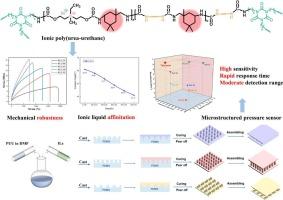Microstructure-oriented high-sensitivity pressure sensor: a cross-linked ionic poly(urea-urethane) with mechanical robustness, elasticity, and ionic liquid affinitation
IF 6.3
2区 化学
Q1 POLYMER SCIENCE
引用次数: 0
Abstract
The primary challenge in developing highly sensitive skin-inspired polymeric sensors with superior strength, toughness, and exceptional self-healing capabilities is the inherent brittleness of the polymer matrix, with the difficulty in constructing efficient charge transport pathways. This study proposed a new type of cross-linked ionic poly(urea-urethane) (PUU) synthesized by strategically incorporating ionic bonds into PUU matrix combining the dynamic cross-linking mechanisms of hindered urea bonds and hydrogen bonds. These materials use electrostatic interactions between the polymer network and ILs to form stable ion transport channels, effectively addressing the liquid leakage issue inherent in conventional ionogels. The synthesized PUU material exhibited outstanding mechanical properties, featuring tensile strength of 13.0 MPa and elongation at break of about 1270 %. More importantly, the PUU network displayed excellent ionic liquid affinity (contact angle of 48.5°) and high self-healing efficiency (80.8 % at 60 °C). Furthermore, flexible sensors constructed by incorporating ionic liquids (ILs) into PUU with special microstructures presented high sensitivity (−6.5 kPa−1), rapid response time (48 ms), and moderate detection range (0.08–4 kPa), enabling precise monitoring of human activities. These multifunctional cross-linked PUU elastomers demonstrate significant potential for applications in robust self-healing materials as well as in resistive pressure sensors.

面向微结构的高灵敏度压力传感器:具有机械稳健性、弹性和离子液体亲和性的交联离子聚脲
开发高灵敏度皮肤激发聚合物传感器,具有优异的强度、韧性和卓越的自愈能力,主要挑战是聚合物基体固有的脆性,难以构建有效的电荷传输途径。本研究结合受阻脲键和氢键的动态交联机制,将离子键策略性地嵌入到PUU基体中,合成了一种新型的交联离子聚脲-氨基甲酸乙酯(PUU)。这些材料利用聚合物网络和il之间的静电相互作用形成稳定的离子传输通道,有效地解决了传统离子凝胶固有的液体泄漏问题。合成的PUU材料具有优异的力学性能,抗拉强度为13.0 MPa,断裂伸长率约为1270%。更重要的是,PUU网络表现出优异的离子液体亲和性(接触角为48.5°)和高自愈效率(60℃时为80.8%)。此外,将离子液体(ILs)加入具有特殊微结构的PUU中构建的柔性传感器具有高灵敏度(−6.5 kPa−1)、快速响应时间(48 ms)和中等检测范围(0.08-4 kPa),能够精确监测人类活动。这些多功能交联PUU弹性体在坚固的自愈材料以及电阻压力传感器中显示出巨大的应用潜力。
本文章由计算机程序翻译,如有差异,请以英文原文为准。
求助全文
约1分钟内获得全文
求助全文
来源期刊

European Polymer Journal
化学-高分子科学
CiteScore
9.90
自引率
10.00%
发文量
691
审稿时长
23 days
期刊介绍:
European Polymer Journal is dedicated to publishing work on fundamental and applied polymer chemistry and macromolecular materials. The journal covers all aspects of polymer synthesis, including polymerization mechanisms and chemical functional transformations, with a focus on novel polymers and the relationships between molecular structure and polymer properties. In addition, we welcome submissions on bio-based or renewable polymers, stimuli-responsive systems and polymer bio-hybrids. European Polymer Journal also publishes research on the biomedical application of polymers, including drug delivery and regenerative medicine. The main scope is covered but not limited to the following core research areas:
Polymer synthesis and functionalization
• Novel synthetic routes for polymerization, functional modification, controlled/living polymerization and precision polymers.
Stimuli-responsive polymers
• Including shape memory and self-healing polymers.
Supramolecular polymers and self-assembly
• Molecular recognition and higher order polymer structures.
Renewable and sustainable polymers
• Bio-based, biodegradable and anti-microbial polymers and polymeric bio-nanocomposites.
Polymers at interfaces and surfaces
• Chemistry and engineering of surfaces with biological relevance, including patterning, antifouling polymers and polymers for membrane applications.
Biomedical applications and nanomedicine
• Polymers for regenerative medicine, drug delivery molecular release and gene therapy
The scope of European Polymer Journal no longer includes Polymer Physics.
 求助内容:
求助内容: 应助结果提醒方式:
应助结果提醒方式:


